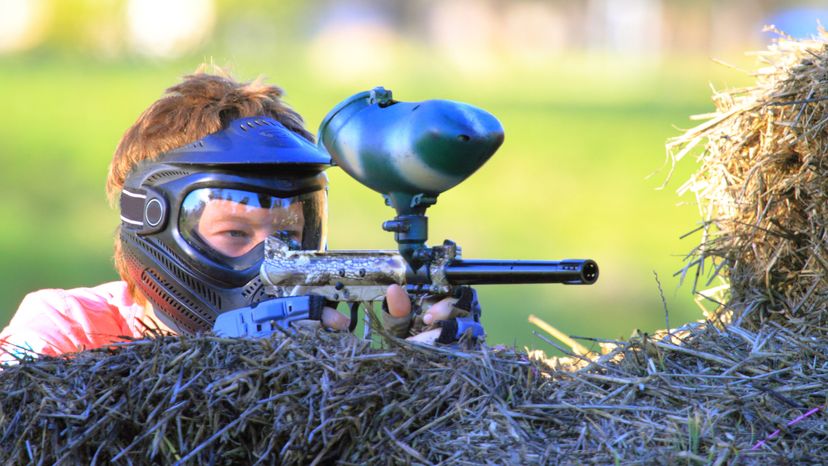
To understand how BB guns work, let's first look at conventional guns. The basic idea behind almost any firearm, from a pistol to a cannon, is to create a small explosion just behind a projectile positioned in a cylinder. When the explosion tries to expand in a gun, it is very limited as to where it can go: The edges of the cylinder are stronger than the force of expansion, so it can't expand out in every direction. The only way it can expand is down the cylinder, the barrel of the gun. If a projectile (a bullet, for example) is in the way, the expanding matter from the explosion will push the projectile forward as it makes its way down the barrel.
The principle behind BB guns is pretty much the same as in firearms, except there is no explosion. The expanding matter is ordinary air, carbon dioxide or some other gas. Before you fire the gun, the gas is compressed so that it has a greater density, and consequently a greater pressure than the air in the atmosphere outside the gun. The compressed gas is stored in an airtight container until you pull the trigger. This opens up the gas container so the gas can flow out into the barrel, just behind the BB. Since it is more compressed, the gas behind the BB pushes out with greater force than the air in the atmosphere pushes in, and the BB is propelled forward at great speed. This is the idea behind all gas-powered guns, including high-powered air rifles and paintball markers.
Advertisement
There are several different air-gun designs, which differ mainly in the source of the compressed air:
- In pneumatic designs, you build up a reservoir of compressed gas by manually pumping air. The movable lever on the bottom of the gun moves a small piston in a tube. Inside the tube, there is a check valve that lets air flow in but not back out. In this way, each pump of the gun increases the amount of air in the reservoir, which has a set volume. Since mass is increased while volume is held constant, the density and pressure of the air increases with every pump.
- Another common system is the spring air design. In this sort of gun, the "pump" lever pushes back on a small piston, which compresses a spring behind it. As the piston slides back, it catches on a small, spring-driven latch that swivels on a tiny pin. This latch, commonly called a sear, holds the piston in position, so the spring stays compressed. When you pull the trigger, it pushes on the sear so it lifts off the piston. With the piston unlatched, the spring can expand out, pushing the piston forward. This quickly compresses the air in the chamber behind the BB, building up the pressure needed to propel it down the barrel.
- Some air guns don't have any sort of pump action. The gas is pre-compressed and stored in cylinders, like the air in a scuba tank. To shoot the BB, the gun mechanism just has to open the pathway between this gas source and the chamber behind the BB (or other projectile). There are many different air-gun designs that accomplish this feat. One of the coolest is the "pump-action" design found in basic paintball guns.
In the middle of the gun, there is a long valve tube. This runs from the barrel to a chamber at the back of the gun, where the gas cartridge is connected. Along this path, the tube passes through the bolt, a spring, the hammer and, at the gas-intake end of the gun, the valve seat. At the barrel end of the gun, the tube is always open. But the openings at the other end, which are positioned along the sides of the tube, are blocked off by the surrounding valve seat. The tube is held in position by a cup seal, pushed against the tube by a small spring and the pressure of the gas in the chamber.
When the gun isn't cocked, the bolt extends into the barrel, blocking the entryway for the ammunition. To cock the gun, the shooter pulls the bolt backward, pushing against the spring so that the bolt butts up against the hammer. This motion does two things:
- As the bolt slides back, the ammunition intake opens so a BB (or paintball) can fall into the barrel.
- On the bottom of the hammer, there is a small sear, which catches hold of the bolt when the bolt is pushed against the hammer. This binds the bolt and hammer together so that they move as one unit.
After pulling the bolt back, the shooter pushes it (along with the hammer) forward. To fire the gun, the shooter pulls the trigger. The trigger pushes up against the back end of the sear, so the front end moves down. This releases the hammer from the bolt, and the spring rapidly propels the hammer backward. As the hammer moves backward, it pushes on a raised lip around the valve tube. This propels the valve tube backward with a burst of force that is greater than the forward force exerted by the rear spring and gas pressure. The valve tube is pushed back for an instant, until the spring pushes it back into place. In this instant, the side openings on the tube are exposed, and the pressurized gas can flow through to the barrel. This burst of gas is strong enough to propel the projectile forward at a good rate of speed.
Here are some interesting links:
Advertisement